For many years, when my bike-riding time exceeded my writing time, I rode to a cemetery each Veterans Day. My helmet off, I’d walk the grounds and pay my respects to each gravesite marked with a war—CAW, WWI, WWII, Korea, Vietnam. I wondered about the Veterans’ stories. What would they say about their service, their sacrifice? Who did they leave behind? What did they want to do with their life before war interrupted their plans? All I could do was say “Thank you.” It never took many graves before I’d find one where the date of death fell within the war years. It always choked me up. Even writing this, I fight the tears back out of my eyes. Men and women gave their lives defending this freedom I enjoy.
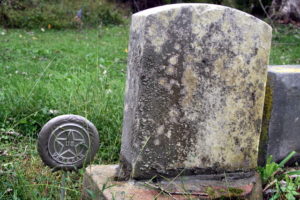
Blank gravestone
My biking time and writing time have reversed, and I no longer make that pilgrimage. When I do come across a cemetery on my vacations, I’ll make a point of finding the ones with the war markers. In July, my sister and I made our first visit to Kentucky’s Mammoth Cave National Park. We drove past Little Hope Cemetery on our way in, and stopped on the way out.
My sister pointed at the biggest marker in the cemetery. “I wonder who that grave belongs to.”
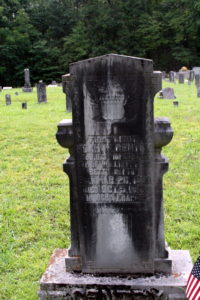
First Lieutenant Gentry Never Returned Home
There, in letters fading from the elements and darkening with algae, stood the story of a man’s sacrifice. His family’s sacrifice. First Lieutenant Noah W. Gentry, Company I, 813, served in World War One, and died on the battlefield in Vichy, France, 1918.
He’d have left a hole in not just his family’s hearts, but also his community’s. As a first lieutenant, Gentry was a commissioned officer. He’d probably have come from a family with prestige, been a strapping lad, I imagined, and ready to return to a college, or maybe his mama and daddy’s farm when that horrible war ended. But he’d laid down his life, fighting for our country. Rest in peace, First Lieutenant Gentry.
GAP Trail
The GAP Trail runs from Cumberland, Maryland, to Pittsburgh, PA. The crushed limestone surface welcomes bicyclists and our loaded bikes. Sites of interest abound, the history of the land. It might be a beautiful waterfall, or a memorial for a mining explosion. When traveling as a group on the trail, a common practice is to ride at the pace that allows you to enjoy the journey, and stop for photos to remember the adventure. We regroup at towns or historical sites. My friends were riding the two trails (CNO & GAP), while I was riding just GAP. Riding ahead of folks on my fresh legs, I cruised to a stop at the Dravo Cemetery in the quiet town of McKeesport, Pennsylvania. I’d been unable to stop on two previous vacations, grinding along on tired legs, and I wasn’t missing it again.
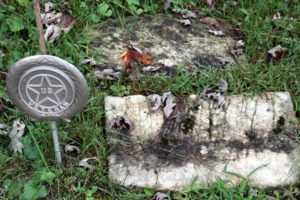
Some headstones have been weathered beyond reading
Grave markers of the poor are the small blocks of stones, or perhaps a round field stone. Headstones flush with the ground feel the full weight of the elements. Letters are worn away until there is no trace; or perhaps no letters ever existed. Likely the family, as much as they grieved for the loss of their son or daughter, could not afford the price of carving. That’s the case of many a gravestone I’ve seen. All I can do is look skyward and once more thank this veteran for their service.
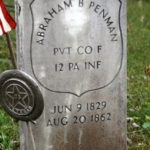
Here lies Private Abraham Penman
In the Civil War, Private Abraham B. Penman served in Company F, 12th Pennsylvania Infantry, 1829-1862. Here lay another lad who gave his life, this time fighting one countryman against another. This stretch of the GAP Trail cuts through steel country, with small houses built to hold multiple families. Private Penman, thank you for your service.
If you’ve lost a member of your family to a war of the past, and don’t know where they are buried, try searching through the US Department of Veterans Affairs.
Thank the Wounded
For several years, my sister and I sent cards to hospitalized service members at Thanksgiving or Christmas or Valentine’s Day, via Walter Reed Medical Center at a Georgia Avenue address. Then, the sad year they were returned, I learned that the center had closed at that location. The Walter Reed page requests that if you see the Facebook post from past years with this address, you correct it—do not send cards there, as they will be returned.
The guidance used to be to write to “Service member” and to send plain cards only: glitter, fur, fuzz, any extra do-dads were a major no-no—you don’t want someone who’s recovering to get glitter in a healing wound, or have a reaction to the embellishment; if we were sending them to Red Cross to go overseas, you didn’t want a service member discovered by the glitter that transferred to their uniform. We never sealed the card in its envelope, because staff reviewed each one to ensure no hateful words were written.
Now that I know the new address for the expanded Walter Reed, I can’t tell if they’re still doing the card program for wounded vets, but it did tell me about a new opportunity:
This year you can also assist a service member, veteran and their families by providing cards they can send home to their loved ones this holiday season. The deadline for all cards including Hanukkah, Christmas and Kwanzaa is Friday, November 30, 2016.
Items to include in each bundle:
- 3 blank holiday cards (same holiday per bundle and no glitter)
- 3 blank envelopes with postage stamps
- 1 short message to the service member (do not included contact information, only first name) Bundled with a ribbon
Please drop off or mail completed bundles to:
American Red Cross in the National Capital Region
ATTN: Holiday Mail for Heroes
8550 Arlington Blvd
Fairfax, VA 22031If you would like to continue sending signed holiday cards in the traditional sense, please contact your local Red Cross office, Military Treatment Facility or VA Hospital to obtain the local guidelines.
Up-to-date information will be posted on our Facebook page and please feel free to call the American Red Cross at 301-295-1538 if you have any questions!
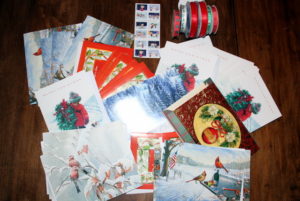
Cards from previous years, mail promotions, and bought specifically for those who have served
I checked the Walter Reed Facebook page, but I don’t see anything about those signed cards I liked to do. Today, Veterans Day, is a perfect one for me to go through Christmas cards left from past years, the ones charities have sent me in the mail as a “thank you” for a donation. Now I know I can send them to the Red Cross, and somewhere, a service member will be able to send a card home to her or his family. I have no excuses–I bought stamps in advance from Costco last year; I have tons of craft ribbon.
On this Veterans Day, I extend my thanks to all my friends and family, to all military, who have served our country or are currently serving. Thank you for the freedom you have allowed me to enjoy.
